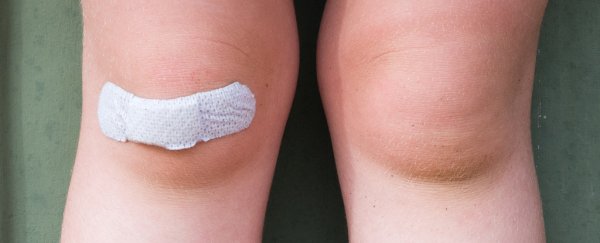Scientists have developed a new type of smart bandage that can signal the type of bacterial infection it's protecting, just like a traffic light, as well as release the right type of drugs on demand.
The researchers behind the design hope it could help to fight back against antibiotic resistance, as well as heal wounds more quickly.
The traffic light system works just like you'd expect: Green means no bacteria or a low concentration of bacteria, yellow means drug-sensitive (DS) bacteria responsive to standard antibiotics (and triggers antibiotic release), and red means drug-resistant (DR) bacteria that need extra help to be wiped out.
The stronger the colour, the higher the concentration of bacteria.
In testing the bandage on mice, the research team was able to successfully treat both DS and DR E. coli infections using the new method.
If drug resistance is detected, an intense beam of light can be used to activate the release of a highly reactive species of oxygen to weaken the bacteria, making them more susceptible to the antibiotic in the material.
 Bandage colours for drug-sensitive (DS) and drug-resistant (DR) bacteria. (ACS Central Science 2020)
Bandage colours for drug-sensitive (DS) and drug-resistant (DR) bacteria. (ACS Central Science 2020)
Antibiotics are released as soon as the infection is detected, and because antibiotic resistance can also be caught, it means additional treatments can be applied before the bacteria have a chance to mutate and defend themselves further.
"Sensing bacterial infections and monitoring drug resistance are very important for the selection of treatment options," write the researchers from the Chinese Academy of Science in China in their published paper.
"However, the common methods of sensing resistance are limited by [time], the requirement for professional personnel, and expensive instruments. Moreover, the abuse of antibiotics causes the accelerated process of bacterial resistance."
It's easy to see how a simple bandage and light could overcome some of these limitations – the basic wound dressing can be easily transported and distributed, and attacks bacteria immediately, without any special equipment or personnel required.
Treatment doesn't have to wait for a doctor to make a diagnosis, and the bandage can get the right sort of drugs applied at the earliest opportunity. Only a small amount of testing has been carried out so far, but there's plenty of potential here.
What's more, the person wearing the bandage gets real-time feedback on what's happening with the infection, if there's an infection at all. The researchers say it offers numerous benefits over existing treatments that make use of light, including photodynamic therapy or PDT.
"Compared with traditional PDT-based antibacterial strategies, our design can alleviate off-target side effects, maximise therapeutic efficacy, and track the drug resistance in real time with the naked eye," the researchers explain in their paper.
We've been seeing quite a few upgrades to the traditional bandage in recent years, thanks to advances in science – like the nanofibre mesh that attracts bacteria and draws some of it out, speeding up the healing process.
Then there's the novel bandage for treating burns, which stops bacteria from multiplying and lowers the risk of infection. The more work that a bandage can do while it's protecting a wound, the better.
Efforts to improve bandages continue – and now we've got a bandage that not only releases antibiotics, but which tells the patient exactly what's going on too.
"This work develops a new way for the rational use of antibiotics," write the researchers in their published paper. "Given the low cost and easy operation of this point-of-care device, it can be developed for practical applications."
The research has been published in ACS Central Science.
